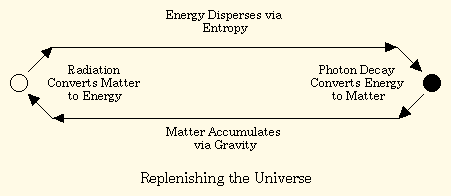Cosmology and the Law of Parsimony
The Black Sky At NightI've asserted that the universe is three dimensional, linear, infinite,
and eternal. Given such a simple universe, the night sky ought to
be white, not black. Here's the reason. If photons don't decay
then, given my assertions, photons have to travel until something gets
in their way. In that case, regardless of which direction you look,
you're looking in the direction of a star, however distant it might be.
You ought to be able to see the light from that star. Thus, the entire
sky, whichever direction you look, ought to be entirely blanketed by a
background of stars. The night sky ought to be white.
There are at least two things that can explain the black sky that we
observe at night. Both of those things are consequences of the red
shift, as I understand it. First, there might be material in space,
between you and any star toward which you're looking. The further
away the star is, the more of that material there might be between you
and it. If the star is far enough away then there might be so much
of the material between you and it that the material completely blocks
your view of the star. What's in the way are the tiny particles of
matter that were deposited by decaying photons. That also explains
the missing mass that the scientists couldn't find, way back at footnote
2 on page 1.
The second reason that the night sky is black instead of white is that
the further a photon travels, the more particles of matter it deposits.
The more particles it deposits, the further its frequency is reduced.
Eventually, its frequency is reduced to the point where the next particle
of matter that it deposits reduces its frequency to zero, and it ceases
to exist. The night sky is black because there's a limit to how far
photons can travel.
Those two phenomena define the visual horizon of the universe, which
we perceive as a black background. We cannot see beyond that visual
horizon. Within it, we can see the bodies and the materials that
reside within the universe. Beyond it, the universe continues without
end but we cannot see it. However far our descendants might travel,
they will never approach the visual horizon. It will move as they
move, remaining always at the same distance from them. It is eternally
unattainable. Thus, any observer will always be at the exact center
of the observable universe.
There's another fascinating consequence of my cosmology. Given
infinity in a Euclidean universe (see page 5), each and every point in
the entire universe, without exception, is at the exact center of the universe.
Think about it. No matter which direction you point, there's exactly
as much of the universe in that direction as there is in any other direction.
So, you're at the very center of the universe. It gets even better.
The exact same thing is true for anybody, anywhere in the entire universe.
No matter which direction he points, there's exactly as much of the universe
in that direction as there is in every other direction. So every
creature, anywhere in the universe, is at the exact center of the universe.
An infinite Euclidean universe consists entirely of nothing but central
points. The ancient practitioners of the geocentric cosmology were
closer to the truth than they ever imagined, but in a way that they could
never have imagined.
 | Page 9 |
|

![]()
